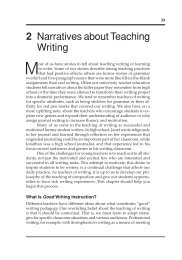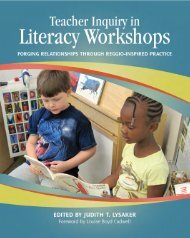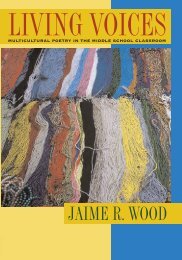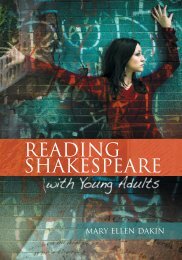Graphic novel Spread - National Council of Teachers of English
Graphic novel Spread - National Council of Teachers of English
Graphic novel Spread - National Council of Teachers of English
- No tags were found...
You also want an ePaper? Increase the reach of your titles
YUMPU automatically turns print PDFs into web optimized ePapers that Google loves.
Introduction—Carving a Niche 1<br />
1 Introduction—Carving a<br />
Niche: <strong>Graphic</strong> Novels in<br />
the <strong>English</strong> Language Arts<br />
Classroom<br />
James Bucky Carter<br />
University <strong>of</strong> Virginia<br />
There is a graphic <strong>novel</strong> for virtually every learner in your <strong>English</strong><br />
language arts classroom. From students who “just like to look at<br />
pictures” to those who are prepared for a heady academic challenge,<br />
interests can be piqued and zones <strong>of</strong> proximal development<br />
(Vygotsky, 1978) enriched by reading a graphic <strong>novel</strong>, herein defined<br />
as a “book-length sequential art narrative featuring an anthology-style<br />
collection <strong>of</strong> comic art, a collection <strong>of</strong> reprinted comic book issues comprising<br />
a single story line (or arc), or an original, stand-alone graphic<br />
narrative” (Carter, 2004). Indeed, just as comics experienced a “Golden<br />
Age” <strong>of</strong> popularity in the United States in the 1940s, comics and the<br />
graphic <strong>novel</strong> are experiencing a burgeoning Golden Age in education<br />
today.<br />
A substantial, expanding body <strong>of</strong> evidence asserts that using<br />
graphic <strong>novel</strong>s and comics in the classroom produces effective learning<br />
opportunities over a wide range <strong>of</strong> subjects and benefits various<br />
student populations, from hesitant readers to gifted students. Studies<br />
<strong>of</strong> comics in the classroom go back to the 1940s at least, but, over the<br />
last decade, librarians have fervently led the way in making the case<br />
for graphic <strong>novel</strong>s as exciting and proper reading material for adolescents.<br />
Many public libraries now have graphic <strong>novel</strong> sections or carry<br />
graphic <strong>novel</strong>s in their stacks. Published studies by <strong>English</strong> language<br />
arts teachers who have used graphic <strong>novel</strong>s in their classes have been<br />
relatively rare, however, and graphic <strong>novel</strong>s still remain largely on the<br />
fringes <strong>of</strong> the pr<strong>of</strong>ession.<br />
But the marginalization <strong>of</strong> the graphic <strong>novel</strong> is changing rapidly.<br />
With the growing understanding <strong>of</strong> the importance <strong>of</strong> critical literacy,<br />
visual literacy, and other types <strong>of</strong> literacy that were once considered<br />
“alternate,” more attention has been paid to graphic <strong>novel</strong>s. The efforts
















